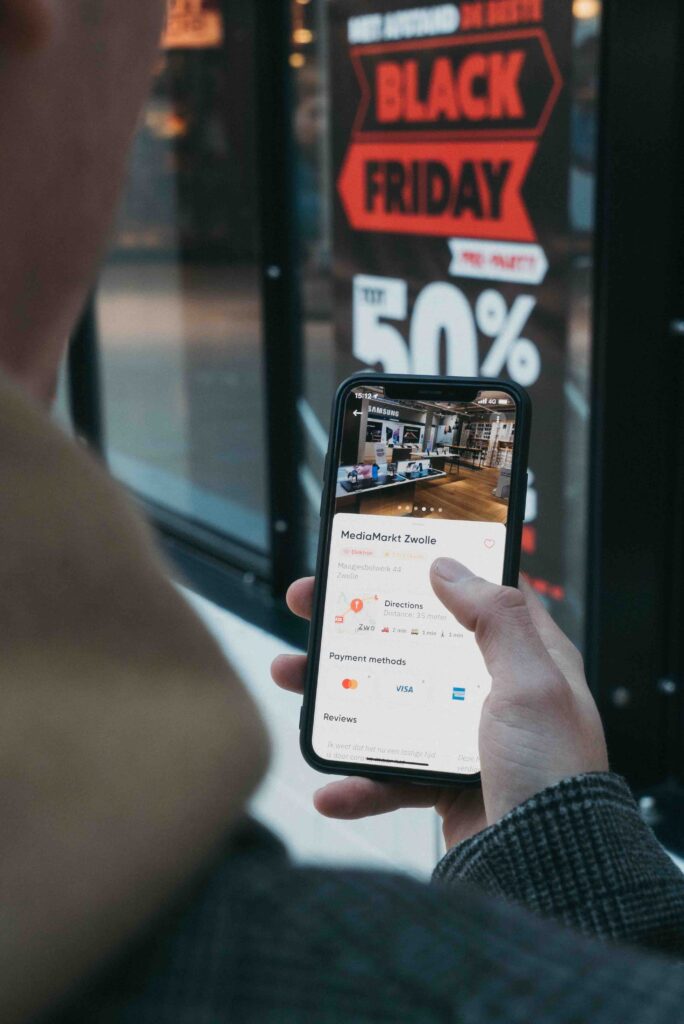In this article, we explore the concept of personalisation in e-commerce, which involves tailoring customer experiences to individual preferences and needs, and we delve into its pivotal role in reshaping the digital shopping landscape for larger brands.
Introduction to Personalisation in E-commerce
As a social agency, we have a wealth of experience working with ecommerce brands. As the market becomes more and more saturated, a powerful and transformative strategy has become required – personalisation. This strategy has reshaped the way brands connect with their customers and is no longer an optional add-on but a vital component of success.
In this article, we analyse what we mean when say ‘personalisation in e-commerce’. Our goal is to provide you with a comprehensive understanding of why personalisation matters and how it can be effectively leveraged, especially by larger brands, to enhance the customer experience and drive business growth.
E-commerce today is a dynamic and competitive arena where consumers are expecting a more tailored experiences that goes beyond a traditional, one-size-fits-all approaches. They seek engagements that resonate with their unique preferences, needs, and desires. This is where personalisation becomes not just an opportunity but a strategic imperative.
We will navigate the complexities of e-commerce personalisation, addressing the nuances and challenges faced by larger brands. By the end of this journey, you will be equipped with the insights, strategies, and expert perspectives needed to embark on your own personalisation journey and ensure your brand remains at the forefront of customer-centric innovation.

With meticulous research, real-world examples, and actionable insights, we aim to demonstrate the power of personalisation and its potential to redefine the customer experience.
What is e-commerce personalisation?
When we say, ‘E-commerce personalisation’ – what we mean is the tailoring of a customer’s experience to meet the individual preferences, needs, and behaviours of each customer. Instead of just offering generic content and product recommendations, this approach allows you to create highly relevant and engaging interactions – making your customers feel extra special.
E-commerce personalisation will typically utilise data, technology, and algorithms to create a customer experience that makes them feel unique and understood. This could include analysing their past purchases, browsing patterns, demographic information, and in some circumstances, even real-time interactions with the e-commerce platform. This more customised shopping experience typically leads to higher conversion rates.
The Landscape of E-commerce Personalisation for Customer Experiences
The world of e-commerce has never been more competitive. Consumer expectations are evolving. As a result, the personalisation of customer experiences has emerged as a pivotal factor in achieving success as an online businesses.
There has been a paradigm shift online, and customers now expect more than just a transactional relationship with brands; they cherish, personalised interactions.
This new importance of personalisation is underscored by statistics revealing its impact on key performance indicators. Research shows that personalised product recommendations can boost conversion rates by as much as 150%. Customers are not just receptive to personalisation; they actively prefer it. A significant 80% of consumers are more likely to engage with brands that offer personalised experiences, and 66% of consumers expect brands to understand their individual needs.
The Evolution of Personalisation Over the Years
The journey of personalisation in e-commerce began with basic tactics such as including a customer’s first name in emails and has evolved into a complex ecosystem of data-driven strategies that encompass every aspect of the shopping journey.
In the early days of e-commerce, personalisation primarily focused on basic segmentation and email marketing. Brands would categorise customers into broad segments based on demographics or purchase history and send generic email campaigns. At the time, this felt like the future of marketing, however, today – it seems antiquated.
As technology advanced, personalisation grew more sophisticated. Machine learning algorithms, predictive analytics, and artificial intelligence (AI) came to the forefront. These technologies enabled e-commerce platforms to understand customers at a granular level.
The rise of omnichannel personalisation is another notable development. E-commerce has expanded beyond traditional websites to encompass mobile apps, social media, voice assistants, and physical stores. Brands now strive to provide consistent and personalised experiences across all these touchpoints. Integrated customer profiles serve as the foundation, allowing businesses to offer seamless transitions between online and offline shopping.

The Role of Data and Technology in Enabling Personalised Experiences
Naturally, the heart of effective e-commerce personalisation lies data and technology. These two pillars are the driving force behind understanding and catering to individual customer preferences. Here’s how they play a pivotal role:
Data Collection
E-commerce platforms collect vast amounts of data, including customer profiles, purchase history, browsing behaviour, and engagement metrics. This data forms the foundation for personalisation efforts, providing valuable insights into what customers want and need. Whilst data collection is often viewed negatively by consumers, a study interestingly showed that 83% of consumers are willing to share their data to create a more personalised experience.
Machine Learning and AI
Machine learning algorithms and AI can identify patterns, detect trends, and make predictions about future customer behaviour. These technologies enable real-time personalisation, where content and recommendations are dynamically adjusted based on the user’s actions.
Recommendation Engines
Recommendation engines, powered by data and AI, drive product discovery and upselling. These engines analyse a customer’s past purchases and behaviours to suggest relevant products or content, thereby increasing the average order value and conversion rates. For example, if you’ve gone to complete your grocery shopping and it’s popped up with items it thinks you may have forgotten.
Segmentation
One of the original forms of customisation, data-driven segmentation divides customers into distinct groups based on shared characteristics or behaviours. This segmentation allows brands to create tailored marketing campaigns and product offerings for each group, increasing relevance and engagement.
Omnichannel Integration
Data and technology enable the seamless integration of personalisation across multiple channels. A customer’s interactions with a brand on social media, email, or a mobile app can inform the personalisation efforts on the brand’s website or in-store. However, this can feel a little creepy to customers, I’m sure we’ve all heard our friends ask “How did they know I wanted that? Have they got me bugged?!”
The Customer’s Perspective
In the modern e-commerce landscape, customers have come to expect personalised experiences that cater to their unique preferences and needs. This shift in expectations is driven by digital technology, data availability, and the influence of personalisation pioneers like Amazon and Netflix. Ever loaded up Amazon after your partner has been using it, to see all your personal recommendations are now shows about whether something is cake or not? Just me?
Let’s consider some of the main areas of the customer’s viewpoint when it comes to personalisation:
Consumer Expectations
Tailored Recommendations: I think it’s fair to say that shoppers now expect personalised product recommendations and a customer experience that feels tailored to them.
Relevant Content: It’s important to consider who your ICP (idela customer profile) is when creating content. Consumers value content that speaks directly to their interests, whether it’s blog articles, offers, or product descriptions.
Efficient Shopping: We all know that convenience is key. Customers appreciate streamlined shopping processes and easy access to features like their own order history.
The Psychology of Personalisation
Sense of Belonging: Personalisation satisfies the human need to belong and be recognised, fostering a sense of connection and loyalty. Consider it the modern-day equivalent of walking into your local coffee shop, and begin greeted by a familiar face who says “do you want your usual?”.
Reduced Decision Fatigue: Customised experiences simplify decision-making by presenting curated options, reducing cognitive load. I find this especially true of online grocery shopping, where the favourites feature makes the experience easier.
Emotional Engagement: We all like to feel special, and experiencing a feeling of personalisation can make customers feel great. When something makes us feel great, we’re likely to go back to it – increasing brand loyalty.
Impact on Behaviour
Increased Conversion Rates: Research shows that personalisation consistently leads to higher conversion rates, as tailored experiences boost the likelihood of purchase.
Increased Loyalty: Customising the customer experience builds long-term customer relationships, fostering loyalty and repeat purchases.
Reduced Cart Abandonment: Personalisation helps reduce cart abandonment rates by providing relevant incentives and reminders. We’ve all received that email ‘have you forgotten something?’.
To conclude, the time of personalisation being a bonus is no more. E-commerce consumers now expect tailored experiences that simplify their shopping journey and resonate with their preferences. This preference is rooted in the sense of belonging, reduced cognitive load, and emotional engagement.
How to Implement Personalisation Strategies
With 7 in 10 retailers who invested in personalising their customer experience reporting to have seen an ROI of at least 4x, I’m sure you are convinced of the importance of a personalised customer experience. But how do you actually implement it? In my experience, it’s best to have a structured approach that leverages data, technology, and various tactics. Here are the key steps for successful implementation:
1. Data Collection and Analysis

Customer Data: Make sure you are collecting comprehensive customer data, including purchase history, browsing behaviour, demographics, and preferences. Please do ensure this is ethical and include prominent notice of what data you collect and how for your customers.
Data Integration: Integrate data from various sources like your website, CRM, and third-party tools to create a holistic customer profile.
Data Security: As well as giving them warning ahead of time, it’s also important to ensure strict data security measures to protect customer information and comply with privacy regulations.
Data Analysis: Employ data analytics and machine learning to extract valuable insights from collected data. This could be through software or even hiring an agency who specialises in data analysis in ecommerce.
2. Customer Segmentation
Segmentation Criteria: Consider how you’d like to segment customers. Start by defining segmentation criteria based on behavioural patterns, demographics, or purchase history.
Dynamic Segments: It could also be useful to create dynamic customer segments that adapt as new data becomes available.
Segmentation Tools: There are lots of great tools out there for customer segmentation, so be sure to utilise marketing automation tools to segment customers effectively.
3. Personalisation Tactics
Product Recommendations: Implement product recommendation algorithms to include suggested products in your customer experience journey.
Email Marketing: Often considered the birthplace of personalisation in marketing, be sure to create personalised email campaigns that consider customer interests, past purchases, and browsing history.
Dynamic Content: A little tricker, but customising website content and design to match individual user preferences can have a big impact on conversion rates.
Personalised Offers: To further build that brand loyalty, offer tailored promotions and discounts to match each customer’s preferences and shopping behaviour.
4. Testing and Optimisation
A/B Testing: As with all good marketing campaigns, be sure to conduct A/B tests to measure the impact of personalisation tactics on conversion rates and other key metrics.
Continuous Improvement: Use data-driven insights to refine personalisation strategies and keep improving results.
5. Compliance and Privacy
Data Protection: Ensure compliance with data protection regulations such as GDPR and CCPA when collecting and using customer data.
Successful implementation of personalisation in e-commerce isn’t an easy task. But following the above steps will set you on your way. Remember, there are also agencies out there that specialise in personalisation and customer experience – it’s always worth having specialists help you.
In Conclusion
Creating customer experiences through personalisation in e-commerce has undergone a remarkable transformation, evolving from a mere buzzword into an indispensable strategy for ecommerce brands. This strategy isn’t just about attracting customers; it’s about engaging them and building lasting relationships that drive business growth.
The Heart of Personalisation: Data-Driven Insights
At the core of effective e-commerce personalisation lies data. The ability to collect, analyse, and leverage customer data is the foundation upon which personalised experiences are built. Brands that invest in understanding their customers’ preferences and behaviours gain a competitive edge in delivering tailored solutions.
Creating Customer Experiences: Psychology and Engagement
Modern consumers have elevated their expectations. They no longer settle for one-size-fits-all experiences; they want personalisation. This shift is deeply rooted in consumer psychology – the need to feel understood, valued, and heard. Personalisation is the conduit through which brands connect with customers on a profound level, creating a sense of trust and loyalty.
The Future of Personalisation: Adapting and Innovating
E-commerce personalisation is probably set to undergo further evolution. The rise of artificial intelligence (AI) and machine learning (ML) in recent years will drive real-time, data-driven personalisation. To stay on top of this, brands will need to stay attuned to emerging trends, from omnichannel experiences and enhanced data protection to hyper-personalisation and immersive technologies. I know, I know – that’s a lot to think about!
The main thing to take away from this article is that, using personalisation to create customer experiences isn’t just a strategy; it’s the approach that sustains customer relationships and fuels business growth. Brands that grasp its potential and ethical considerations will ultimately win.






